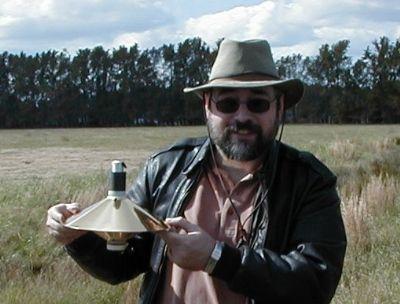Art Applewhite Rockets Delta Flying Saucer 38mm (10")
Art Applewhite Rockets - Delta Flying Saucer 38mm (10") {Kit}
Contributed by Will Marchant
| Construction Rating: | starstarstarstarstar |
| Flight Rating: | starstarstarstarstar |
| Overall Rating: | starstarstarstarstar |
| Manufacturer: | Art Applewhite Rockets  |
 Brief:
Brief:
This is an easy to build, single stage flying saucer that needs no recovery
system. It is an easy way to certify level 1 for high power. Relatively slow
ascent and limited altitude mean a short walk during recovery.
Construction:
A central paper/foam laminate "plate" with a 38mm motor mount tube
installed perpendicular to the plane of the plate makes the main structure of
the rocket. The forward cone is of paper, reinforced with epoxy soaked
fibreglas tape. The aft cone is of unreinforced paper. No motor retention is
included.
The instructions were quite clear and well illustrated. When I had questions, Art answered emails quickly and appropriately. Assembly was logical and took me several short evenings. The paper and foam parts came pre-marked and the explicit instructions made it easy to cut them. A launch lug is not used--there are holes in the plate and fore and aft cones to accomodate a 1/4" launch rod. It is critical that these holes be aligned when the cones are glued to the plate. I wish I had drawn an alignment line on the motor mount tube to aid the assembly of the cones. No special tools are required. Adhesives are white glue and slow setting epoxy.
Finishing:
A number of different "pre-finished" paper cones are available. I
chose the metallic gold paper and did no further finishing. A plain paper
version is available that will allow the user freedom to design their own paint
scheme.
Construction Rating: 5 out of 5
Flight:
There are a large number of recommended 38mm motors: Cesaroni Pro38 G69 and
H153 reloads, Aerotech RMS-38/240 H73J, H123W, H148R, H112J, I161W, and I218R
reloads, and Ellis Mountain H48 and I134 single use motors. I used an Ellis
Mountain H48-8 for my first flight, which was my Tripoli level 1 certification
flight. Reloadable motors should not use the ejection charge. For single use
motors the ejection charge should be removed per the directions.
Recovery:
This kit uses "aerobrake" recovery. The rocket has large surface area
and a very low weight. It recovers nose first at a surprisingly low speed.
There was no damage and only a slight amount soil clung to the forward end of
the engine casing.
Flight Rating: 5 out of 5
Summary:
This was a very easy kit to build. It is an unusual design and attracts a lot
of attention at the flying field. The simplicity of the design lends itself to
a certification flight. The low and slow flight is quite exciting and almost
guarantees a short walk for recovery.
Overall Rating: 5 out of 5
 |
 |